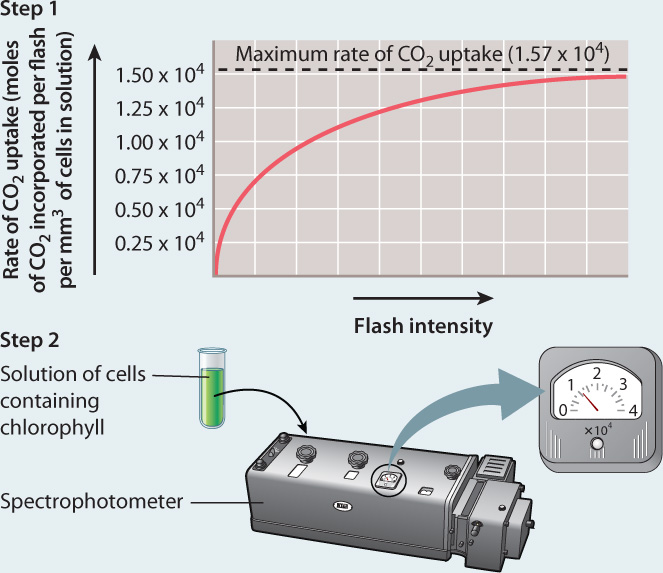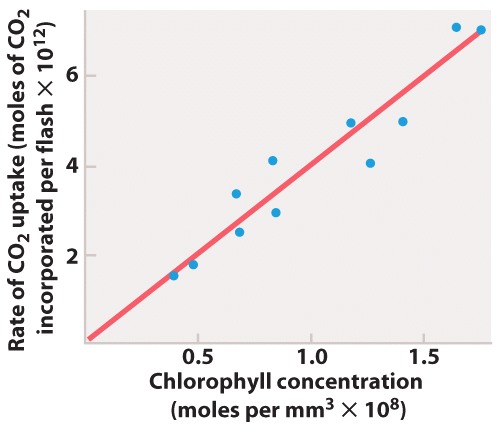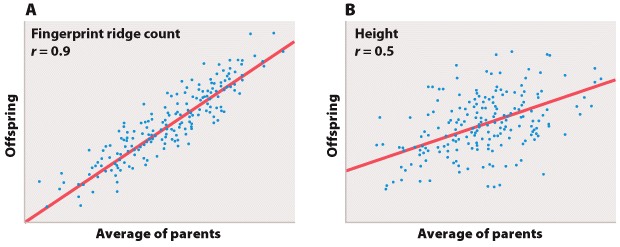Chapter 1. Working With Data 8.11
Working with Data: HOW DO WE KNOW? Fig. 8.11
Fig. 8.11 describes experiments showing that chlorophyll molecules act in groups to incorporate a single CO2 molecule into carbohydrate. Answer the questions after the figure to practice interpreting data and understanding experimental design. These questions refer to concepts explained in the following three brief data analysis primers from a set of four available on Launchpad:
- Experimental Design
- Statistics
- Scale and Approximation
You can find these primers by clicking on the button labeled “Resources” in the menu at the upper right on your main Launchpad page. Within the following questions, click on “Primer Section” to read the relevant section from these primers. Click on the button labeled “Key Terms” to see pop-up definitions of boldface terms.
HOW DO WE KNOW?
FIG. 8.11: Do chlorophyll molecules operate on their own or in groups?
BACKGROUND By about 1915, scientists knew that chlorophyll was the pigment responsible for absorbing light energy in photosynthesis. However, it was unclear how these pigments contributed to the reduction of CO2. The American physiologists Robert Emerson and William Arnold set out to determine the nature of the “photochemical unit” by quantifying how many chlorophyll molecules were needed to incorporate one CO2 molecule into carbohydrate.
EXPERIMENT Emerson and Arnold exposed flasks of the green alga Chlorella to flashes of light of such short duration (10–5 s) that each chlorophyll molecule could be “excited” only once, and the time between flashes was long enough to allow the reactions resulting from this light energy to run to completion. In step 1, they recorded the maximum rate of CO2 uptake by increasing the intensity of the light flashes until the rate could not go any higher. In step 2, they determined the concentration of chlorophyll present in their solution of cells. They then compared the maximum rate of CO2 uptake to the number of chlorophyll molecules.
RESULTS

CONCLUSION Because the maximum rate of CO2 uptake per flash was much smaller than the amount of chlorophyll in their flask, Emerson and Arnold concluded that each photochemical unit contains many chlorophyll molecules.
FOLLOW-UP WORK Emerson and Arnold’s work was followed by studies that demonstrated that the photosynthetic electron-transport chain contains two photosystems (photosynthetic units) arranged in series.
SOURCE Emerson, R., and W. Arnold. 1932. “The Photochemical Reaction in Photosynthesis.” Journal of General Physiology. 16:191–205.
Question
The graph in Fig. 8.11 shows the relationship between two variables: flash intensity and rate of CO2 uptake per mm3 of solution (a measure of photosynthetic rate). Given that the values of an independent variable are controlled by the investigators, while the dependent variable is the effect that is being measured, which of the following statements is true?
| A. |
| B. |
| C. |
| D. |
| variable | A quantity, feature, or factor that can change or be changed. |
| independent variable | The manipulation performed on the test group by the researchers. |
| dependent variable | The effect that is being measured. |
Experimental Design
Testing Hypotheses: Variables
When performing experiments, researchers manipulate the test group differently from the control groups. This difference is known as a variable. There are two types of variables. An independent variable is the manipulation performed on the test group by the researchers. It is considered “independent” because the researchers could choose any variable they wish. The dependent variable is the effect that is being measured. It is considered “dependent” because the expectation is that it depends on the variable that was changed. In our example of the headache medicine, the independent variable is the type of medicine (new medicine, no medicine, placebo, or medicine known to be effective). The dependent variable is the presence or absence of headache following treatment.

